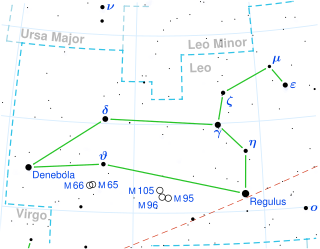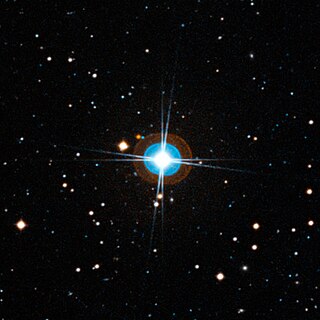Related Research Articles

Epsilon Indi, Latinized from ε Indi, is a star system located at a distance of approximately 12 light-years from Earth in the southern constellation of Indus. The star has an orange hue and is faintly visible to the naked eye with an apparent visual magnitude of 4.83. It consists of a K-type main-sequence star, ε Indi A, and two brown dwarfs, ε Indi Ba and ε Indi Bb, in a wide orbit around it. The brown dwarfs were discovered in 2003. ε Indi Ba is an early T dwarf (T1) and ε Indi Bb a late T dwarf (T6) separated by 0.6 arcseconds, with a projected distance of 1460 AU from their primary star.

CoRoT was a space telescope mission which operated from 2006 to 2013. The mission's two objectives were to search for extrasolar planets with short orbital periods, particularly those of large terrestrial size, and to perform asteroseismology by measuring solar-like oscillations in stars. The mission was led by the French Space Agency (CNES) in conjunction with the European Space Agency (ESA) and other international partners.

R Leonis is a red giant Mira-type variable star located approximately 370 light years away in the constellation Leo.

Nu2 Canis Majoris (ν2 Canis Majoris) is a single star in the southern constellation of Canis Major.

Eta Cephei is a star in the northern circumpolar constellation of Cepheus. With an apparent visual magnitude of 3.4, this is a third magnitude star that, according to the Bortle Dark-Sky Scale, is readily visible to the naked eye. Parallax measurements put it at a distance of 46.53 light-years from Earth.

HD 47536 is a single star in the southern constellation of Canis Major. It has an orange hue and is dimly visible to the naked eye with an apparent visual magnitude of +5.25. The star is located at a distance of approximately 408 light years from the Sun based on parallax. It is drifting further away with a radial velocity of 80 km/s.

HD 13189 is an 8th magnitude star in Triangulum constellation.
HD 204313 is a star with two and possibly three exoplanetary companions in the southern constellation of Capricornus. With an apparent magnitude of 7.99, it is an eighth magnitude star that is too faint to be readily visible to the naked eye. The star is located at a distance of 157 light years from the Sun based on parallax measurements, but it is drifting closer with a radial velocity of −10 km/s.
HIP 5158 is a 10th magnitude K-type main-sequence star located approximately 169 light years away in the constellation Cetus. This star is smaller, cooler, fainter, and less massive than the Sun, but it is more metal rich, having concentration of heavy elements equal to 125% of solar abundance.
HIP 70849 is a star with two non-stellar companions in the southern constellation Lupus. It is a 10th magnitude star, making it too faint to be visible to the naked eye. The system is located at a distance of 78.7 light-years from the Sun based on parallax measurements.
Gliese 676 is a 10th-magnitude wide binary system of red dwarfs that has an estimated minimum separation of 800 AU with an orbital period of greater than 20,000 years. It is located approximately 54 light years away in the constellation Ara. In 2009, a gas giant was found in orbit around the primary star, in addition to its confirmation in 2011 there was also a strong indication of a companion; the second gas giant was characterised in 2012, along with two much smaller planets.

HD 10180, also designated 2MASS J01375356-6030414, is a Sun-like star in the southern constellation Hydrus that is notable for its large planetary system. Since its discovery, at least six exoplanets have been observed orbiting it, and some studies have proposed up to nine potential planets, which would make it potentially the largest of all known planetary systems, including the Solar System.
HIP 13044 is a red horizontal-branch star about 2,300 light years from Earth in the constellation Fornax. The star is part of the Helmi stream, a former dwarf galaxy that merged with the Milky Way between six and nine billion years ago. As a result, HIP 13044 circles the Galactic Center at a highly irregular orbit with respect to the galactic plane. HIP 13044 is slightly less massive than the Sun, but is approximately seven times its size. The star, which is estimated to be at least nine billion years old, has passed the red-giant phase. The relatively fast rotation of the star may be due to having engulfed one or more planets during the red-giant phase.

Gamma Sagittae, Latinized from γ Sagittae, is the brightest star in northern constellation of Sagitta. A single star, it is visible to the naked eye with an apparent visual magnitude of +3.47. Based upon an annual parallax shift of 12.62 mas as seen from Earth, it is located about 288 light-years from the Sun. It is moving closer to the Sun with a radial velocity of −34 km/s.
BD+48 740 is a giant star suspected of having recently engulfed one of its planets. The star's atmosphere has an overabundance of lithium, a metal that is destroyed by nuclear reactions in stars.
HD 38858 is a G-type star, much like The Sun, with one detected planet. The planet, designated HD 38858 b, is about twice the mass of Uranus and orbits in the star's habitable zone.
HD 5608 is an orange-hued star in the northern constellation of Andromeda with one known planet, HD 5608 b. It is a dim star near the lower limit of visibility to the naked eye, having an apparent visual magnitude of +5.98. The distance to HD 5608, as estimated from an annual parallax shift of 17.18 mas, is 190 light years. It is moving closer to the Earth with a heliocentric radial velocity of −23 km/s, and is expected to make its closest approach in 1.285 million years when it comes to within 124 light-years.

HR 6819, also known as HD 167128 or QV Telescopii, is a double star system in the southern constellation of Telescopium. It is in the south-western corner of the constellation, near Pavo to the south and Ara to the west. The system appears as a variable star that is dimly visible to the naked eye with an apparent magnitude that ranges from 5.32 down to 5.39, which is comparable to the maximum brightness of the planet Uranus. It is about 1,120 light years from the Sun, and is drifting farther away at a rate of 9.4 km/s. Due to its location in the sky, it is visible only to observers south of 33°N latitude.
HD 215152 is the Henry Draper Catalogue designation for a star in the zodiac constellation of Aquarius. It has an apparent visual magnitude of 8.13, meaning it is too faint to be seen with the naked eye. Parallax measurements provide distance estimates of around 70 light years. The star has a relatively high proper motion, moving across the sky at an estimated 0.328 arc seconds per year along a position angle of 205°.

HD 196737, also designated as HR 7893, is a solitary orange hued star located in the southern constellation Microscopium. It has an apparent magnitude of 5.47, allowing it to be faintly visible to the naked eye. The object is located relatively close at a distance of 241 light years based on Gaia DR3 parallax measurements, but is receding with a heliocentric radial velocity of 14.2 km/s. At its current distance, HD 196737's brightness is diminished by 0.14 magnitudes due to interstellar dust. It has an absolute magnitude of 1.17.
References
- ↑ Staff, Space.com (28 March 2012). "Ancient Alien Planets Shake Up View of Early Universe". Space.com. Space.com. Retrieved March 29, 2012.
- 1 2 3 4 5 6 7 8 9 10 11 12 "HD 16031". SIMBAD . Centre de données astronomiques de Strasbourg . Retrieved March 29, 2012.
- 1 2 3 4 5 Setiawan, J.; Roccatagliata, V.; Fedele, D.; Henning, Th.; Pasquali, A.; Rodríguez-Ledesma, M. V.; Caffau, E.; Seemann, U.; Klement, R. J. (March 2012). "Planetary companions around the metal-poor star HIP 11952" (PDF). Astronomy and Astrophysics. 540: A141. arXiv: 1208.4000 . Bibcode:2012A&A...540A.141S. doi:10.1051/0004-6361/201117826. S2CID 53700801.
- 1 2 3 4 Schneider, Jean (23 March 2012). "Notes for Star HIP 11952". Extrasolar Planets Encyclopedia. Retrieved March 29, 2012.
- 1 2 Than, Ker (26 March 2012). "Oldest Alien Planets Found—Born at Dawn of Universe". National Geographic Daily News. National Geographic. Retrieved March 29, 2012.
- ↑ O'Neill, Ian (27 March 2012). "Most ancient, 'Impossible' Alien Worlds Discovered". Discovery News. Discovery News. Archived from the original on 2 April 2012. Retrieved March 29, 2012.
- 1 2 Desidera, S; et al. (June 2013). "The GAPS programme with HARPS-N at TNG. II. No giant planets around the metal-poor star HIP 11952". Astronomy and Astrophysics. 554: 29–33. arXiv: 1302.3093 . Bibcode:2013A&A...554A..29D. doi:10.1051/0004-6361/201321155. S2CID 119202972.
- ↑ Müller, A.; Roccatagliata, V.; Henning, Th.; Fedele, D.; Pasquali, A.; Caffau, E.; Rodríguez-Ledesma, M. V.; Mohler-Fischer, M.; Seemann, U.; Klement, R. J. (2013). "Reanalysis of the FEROS observations of HIP 11952". Astronomy and Astrophysics. 556: id.A3. arXiv: 1307.5072 . Bibcode:2013A&A...556A...3M. doi:10.1051/0004-6361/201321497. S2CID 45365535.